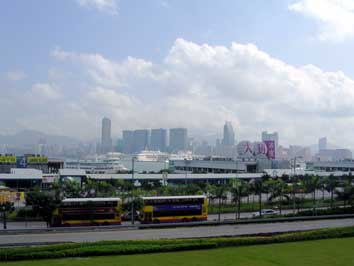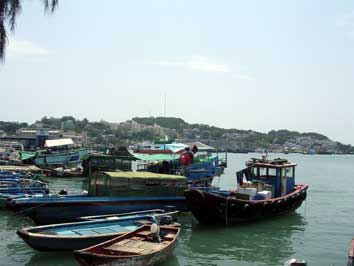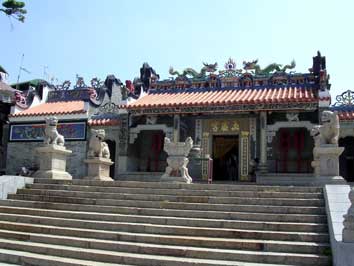| Cheung Chau Walking Guide (MAP) (provided by Hong Kong Tourism Board in 2003) |
|
 |
|
|
|
| To get to Cheung Chau, take the ferry from Outlying Islands Ferry Pier No.5 in Central. Information about ferry schedules can be obtained from Hong Kong Tourism Board Visitor Information and Services Centers. When you arrive at Cheung Chau, walk north along Pak She Praya Road. | |
 |
|
| Ferry passengers arriving on Cheung Chau are often fascinated by the sight of fishing families maintaining traditional life styles aboard authentic wooden junks equipped with radar and computer systems. There is no vehicular traffic on this tiny, dumbbell-shaped island, which is ideal for walking and soaking up the traditional atmosphere. Hugging the shore on reclaimed land, Praya Street uses the Portuguese name (imported via Macau) for a harborside avenue - the "Praya". Along the waterfront, seafood is dried in the sun and fishmongers sell fresh shellfish and seafood in shops and restaurants. In the evenings, the road becomes a colorful Mediterranean-style promenade for islanders; at weekends it is lively with day-trippers from all over Hong Kong. | |
|
|
| Pak Tai Temple lies right behind the big playground. | |
 |
|
| Built more than two centuries ago, the temple is dedicated to the Taoist god of the sea, the "Supreme Emperor of the Dark Heaven". Pak Tai's power is symbolized by the serpent and tortoise under his feet. Before his altar are statues of two generals, "Thousand Miles Eye" and "Favorable Wind Ear", who are said to be able to see and hear from any distance. Side halls display images of the Green Dragon and White Tiger, and the complex includes many features of traditional Chinese temple architecture, such as ceramic figurines on roof ridges and stone lions on the forecourt. In the 18th Century, Cheung Chau was devastated by a plague and infiltrated by pirates - until local fishermen brought an image of the god Pak Tai to the island. Paraded through the village lanes, the deity drove away evil spirits. Every year on the 8th day of the fourth month of the Lunar calendar, the islanders organize a week-long thanksgiving, the Cheung Chau Bun Festival (usually in April or May). The festival features huge towers covered with buns erected in front of the Pak Tai Temple and a street procession in which costumed children appear to float above the crowds, supported by hidden rods and wires. Pak Tai Temple is open daily 9am to 5pm. | |
|
|
| From Pak Tai Temple, walk along Rak She Street and San Hing Street. | |
| Pak She Street and San Hing Street form Cheung Chau's old main street. The scene is typical of island communities: three-storey balconied shop-houses flank a narrow pedestrian lane which follows the contour of the original coastline before it was reclaimed. Stroll along these streets past rebuilt blocks and modern shops and you will see people still practicing traditional trades - baking lotus-seed cakes, dispensing herbal medicine or manufacturing and selling Cheung Chau's famed, pungent, purplish-brown shrimp paste. In clan and community associations, memorial plaques and photographs line the walls. | |
|
|
| From San Hing Street turn into Tung Wan Road and continue until you come to Cheung Chau Beach Road. | |
 |
|
| Cheung Chau's "town" crowds the narrow sandbar linking the two hilly ends of the island. On the eastern side, only a few minutes' walk across the island from the ferry pier, is Tung Wan, a popular public beach. In the waters off to the right beyond the Warwick Hotel Cheung Chau, Hong Kong's first Olympic Games gold medalist (in 1996), Lee Lai-shan, practiced as a schoolgirl. The local Windsurfing Center teaches the sport. | |
|
|
| Walk uphill along Cheung Chau Sports Road and turn right into Kwun Yam Wan Road, Kwan Kung Pavilion lies ahead. | |
 |
 |
| Inland from Tung Wan, the colorful Kwan Kung Pavilion is a gilded, lacquered temple dedicated to Kwan Tai, the Taoist God of War and Righteousness. Leave the temple, walk down Peak Road to Police Station Path and into Tung Wan Road. From there you can catch the ferry back to Central. | |
| Related Sites | |
| [Back to the page of General Travel Links] [Back to the travelogue of Hong Kong and Macau in 2004] |
|